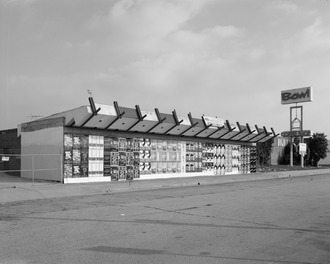Holiday Bowl (building) facts for kids
Quick facts for kids Holiday Bowl |
|
|---|---|

Holiday Bowl in 2002
|
|
| General information | |
| Architectural style | Googie |
| Address | 3730 Crenshaw Blvd. |
| Town or city | Los Angeles, California |
| Country | United States |
| Coordinates | 34°01′09″N 118°20′05″W / 34.0191°N 118.3346°W |
| Current tenants | Starbucks, Walgreens |
| Construction started | 1958 |
| Technical details | |
| Floor count | 1 |
| Design and construction | |
| Architect | Helen Liu Fong |
| Architecture firm | Armet & Davis |
The Holiday Bowl was a popular bowling alley located on Crenshaw Boulevard in Los Angeles, California. It first opened its doors in 1958. This special place was founded by five Japanese-American entrepreneurs. It played a big part in helping the Nikkei community rebuild after many Japanese-Americans were sent to special camps during World War II. To help build the Holiday Bowl, its owners sold shares to people throughout the community.
Contents
A Welcoming Place for Everyone
The Holiday Bowl was more than just a place to bowl. It was important because it welcomed people from all backgrounds. It served Anglo-American, African-American, and Japanese-American customers, helping to bring people together in Los Angeles.
The coffee shop inside the Holiday Bowl was famous for its amazing food. You could find many different dishes there, like grits, udon noodles, chow mein, and hamburgers. It was a place where different cultures met through food!
This bowling alley was a key part of the Crenshaw area for four decades. It was a cultural, architectural, and fun spot for the community. Some even compared its importance to the Hollywood Bowl in the Hollywood Hills.
History of the Holiday Bowl
Japanese entrepreneurs built the Holiday Bowl in 1958. It was a combination of a bowling alley, a pool hall, a bar, and a coffee shop. It was especially important for Crenshaw's Japanese residents. Many of them had faced difficult times, including being held in camps like Manzanar during World War II. They had also faced unfair rules, like a ban from the American Bowling Congress.
The Holiday Bowl was a lively place, even late at night. Aerospace workers and jazz musicians would often visit at 4 a.m. It was a real symbol of community. One story described its 1950s-style orange and green decorations. It also had a huge window with a great view of Baldwin Hills.
Over the years, the Holiday Bowl's ownership changed a few times. It continued to offer a huge variety of ethnic foods. You could find Japanese dishes like harusame and yakisoba. There were also Chinese foods like many kinds of chow mein and Foo young. And for those who loved Southern comfort food, there were hot links, grits, and biscuits and gravy.
The owner was very proud of the Holiday Bowl's long history. He was also proud that it was designed by Armet & Davis. This architectural firm became famous for its unique Googie architecture style. They designed diners like the Holiday Bowl to look modern and optimistic. The building was so strong that it was not damaged during the 1992 Los Angeles riots. People even continued to bowl there that very night!
Cool Googie Architecture
The Holiday Bowl is a great example of Googie architecture. This style is known for its bold shapes, bright colors, and futuristic look. It was very popular in the 1950s. The famous architectural firm Armet & Davis designed the Holiday Bowl.
A talented designer named Helen Liu Fong worked for Armet & Davis. She is given credit for designing the Holiday Bowl. Her work helped define the "Googie" look of the 1950s. The Bowl was even photographed in 3-D by Jack Laxer!
Closure and New Life
The Holiday Bowl closed its doors in 2000. There were plans to tear it down. However, many people who loved the Bowl worked hard to save it. They convinced the City of Los Angeles's Cultural Heritage Commission to declare it an historical monument. It is now listed as number 688 on the City of Los Angeles Historic Cultural Monument list.
In October 2004, the front part of the old bowling alley was updated. It became a modern shopping center that opened in early 2006. Today, the former coffee shop is a Starbucks. Other restaurants from the old alley have also been updated. Even the cool neon signs from a nearby car dealership were improved. People wanted to save this landmark because of its rich history, cultural importance, and unique architecture.

